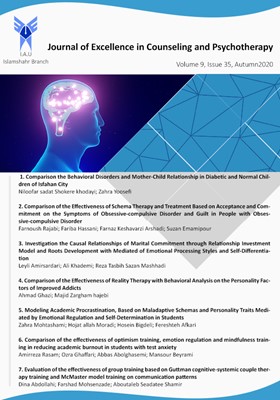-
-
List of Articles
-
Open Access Article
1 - Comparison the Behavioral Disorders and Mother-Child Relationship in Diabetic and Normal Children of Isfahan City
Niloofar sadat Shokere khodayi Zahra Yoosefi -
Open Access Article
2 - Comparison of the Effectiveness of Schema Therapy and Treatment Based on Acceptance and Commitment on the Symptoms of Obsessive-compulsive Disorder and Guilt in People with Obsessive-compulsive Disorder
Farnoush Rajabi Fariba Hassani Farnaz Keshavarzi Arshadi Suzan Emamipour -
Open Access Article
3 - Investigation the Causal Relationships of Marital Commitment through Relationship Investment Model and Roots Development with Mediated of Emotional Processing Styles and Self-Differentiation
Leyli Amirsardari Ali Khademi Reza Tasbih Sazan Mashhadi -
Open Access Article
4 - Comparison of the Effectiveness of Reality Therapy with Behavioral Analysis on the Personality Factors of Improved Addicts
Ahmad Ghazi Majid Zargham hajebi -
Open Access Article
5 - Modeling Academic Procrastination, Based on Maladaptive Schemas and Personality Traits Mediated by Emotional Regulation and Self-Determination in Students
Zahra Mohtashami Hojat allah Moradi Hosein Bigdeli Fereshteh Afkari -
Open Access Article
6 - Comparison of the effectiveness of optimism training, emotion regulation and mindfulness training in reducing academic burnout in students with test anxiety
Amirreza Rasam Ozra Ghaffari Abbas Abolghasemi Mansour Beyrami -
Open Access Article
7 - Evaluation of the effectiveness of group training based on Guttman cognitive-systemic couple therapy training and McMaster model training on communication patterns
Dina Abdollahi Farshad Mohsenzade Aboutaleb Seadatee Shamir
-
The rights to this website are owned by the Raimag Press Management System.
Copyright © 2021-2025







